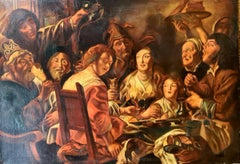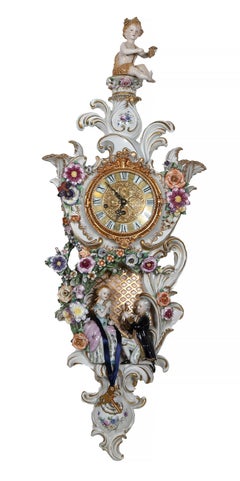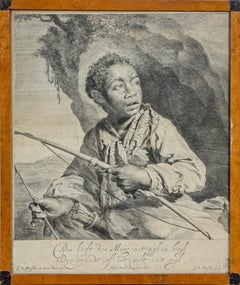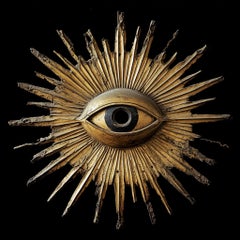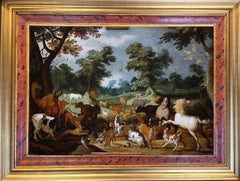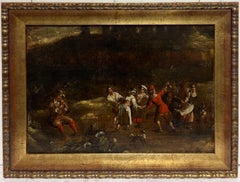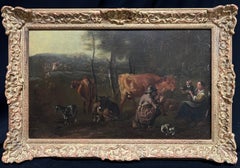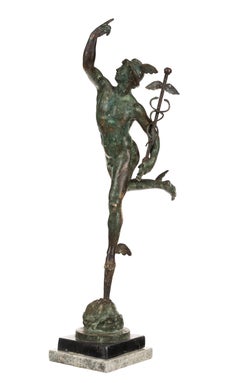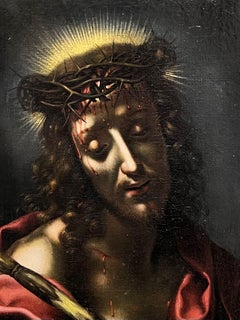Baroque Art
to
176
175
98
96
89
129
Overall Width
to
Overall Height
to
271
61
96
159
2
3
5
3
35
1
1
1
3
5
83
116,982
65,323
53,437
26,838
14,822
9,475
6,074
5,759
4,166
3,022
2,530
2,259
2,243
713
299
200
19
363
223
138
123
110
62
49
47
37
28
19
17
16
13
12
11
11
11
10
8
341
304
166
163
76
55
24
10
10
6
252
63
299
273
Style: Baroque
Fine 17th Century Florentine Baroque Old Master Oil Painting St. John Evangelist
Located in Cirencester, Gloucestershire
St. John the Evangelist
circle of Carlo Dolci (Florence, 1616-1686)
oil painting on canvas, framed
canvas: 30 x 25 inches
framed: 36 x 32 inches
condition: relined canvas, presented ...
Category
17th Century Baroque Art
Materials
Canvas, Oil
"Earthly Paradise" Frédérick Bouttats (Antwerp, 1590-1661)- Studio of
Located in SANTA FE, NM
The Earthly Paradise
Frédérick Bouttats (Antwerp, 1590-1661)
Painting is Circa 1610-1612
Oil on wood panel, circa 42 7/8 x 29 3/8 (ca. 52 x 39 frame) inches
The inner frame is c18th ...
Category
1610s Baroque Art
Materials
Oil, Wood Panel
$46,000 Sale Price
20% Off
17th Century Flemish Old Master Dancing Figures Musicians Antique Oil Painting
Located in Cirencester, Gloucestershire
Dancing Figures
Flemish School, 17th century
oil on on canvas, framed
framed: 21.5 x 28.5 inches
canvas : 16.5 x 24 inches
Provenance: private collection, France
Condition: very good...
Category
17th Century Baroque Art
Materials
Oil
$2,545 Sale Price
30% Off
17th-Century Dutch Pastoral Scene Figures Cattle Goats in a Bucolic Landscape
Located in Cirencester, Gloucestershire
Pastoral Scene with Figures
Dutch Old Master, 17th century
oil on canvas, framed
Framed: 16.5 x 24 inches
Canvas : 13 x 21 inches
Provenance: private collection, UK
Condition: very g...
Category
17th Century Baroque Art
Materials
Oil
After Giambologna Bronze of Mercury with green patina
By Giambologna
Located in New York, NY
Mercury, circa 1700s. Bronze with green patina. Height with base: 58 cm (22 7/8 in.)
Category
Early 18th Century Baroque Art
Materials
Bronze
Christ Crowned With Thorns Sacred Oil Painting 17th Century Old Master Oil
Located in Cirencester, Gloucestershire
Christ In Thorns
"Ecce Homo"
Italian School, 17th century
Oil painting on canvas, framed
Framed: 19 x 16.5 inches
Canvas: 12 x 10 inches
Condition: Good and sound (the frame is loose and weak and disjointed; we offer it free of charge with the painting and do not warranty its condition).
Provenance: Private collection, France
This poignant oil on canvas painting captures a powerful and intimate portrayal of Christ crowned with thorns...
Category
17th Century Baroque Art
Materials
Oil
17th Century Painting Baroque Madonna & Child Attendant Angels Offering Gifts
Located in Cirencester, Gloucestershire
The Angelic Visitation
Italian School, 17th Century
oil on canvas, framed
Framed: 30 x 36 inches
Canvas: 24 x 29 inches
Provenance: private collection, Europe
Condition: the antique...
Category
17th Century Baroque Art
Materials
Oil
Fine 1700's Italian Old Master Oil Painting Hunting Dogs with Game, Roman Ruins
Located in Cirencester, Gloucestershire
Artist/ School: Italian School, early 18th century
The painting is almost certainly from the circle of the Italian Baroque painter known as 'Rosa da Napoli', Jacob Roos (Rome 1682-Na...
Category
Early 18th Century Baroque Art
Materials
Oil
$5,385 Sale Price
30% Off
Allegory of Love : Woman surrounded by Angels and Doves - Etching
Located in Paris, IDF
Francois BOUCHER
Allegory of Love : Woman surrounded by Angels and Doves
Etching
Unsigned
On Vellum 38 x 50 cm (c. 15 x 20 in)
Probably edited c. 1950
Excellent condition
Category
20th Century Baroque Art
Materials
Etching
Le Mousquetaire Musketeer Cavalier Spanish Tradition Diego Velázquez Influence
Located in Sutton Poyntz, Dorset
Ferdinand Victor Leon Roybet.
French ( b.1840 – d.1920 ).
Le Mousquetaire.
Oil On Panel.
Signed Upper Right.
Image size 31.1 inches x 24.4...
Category
Late 19th Century Baroque Art
Materials
Oil, Wood Panel
18th Century Italian Old Master Tempera on Panel Painting "Jesus Road to Emmaus"
Located in Portland, OR
An important 18th century Italian Old Master tempera on copper panel Baroque painting, "The Road to Emmaus", circa 1700.
The painting represents the early resurrection biblical story...
Category
Early 18th Century Baroque Art
Materials
Copper
Baroque Italian master - 17/18th century figure sculpture - The Virgin
Located in Varmo, IT
Carved and painted wooden sculpture - Madonna praying - Italy, 17th-18th century.
35 x 20 x h 65 cm.
Entirely in carved, lacquered and painted wood. Some missing parts and color lo...
Category
Late 17th Century Baroque Art
Materials
Wood, Paint
$2,389 Sale Price
33% Off
The Tooth-Puller (Il Cavadenti) - Oil on Canvas by Follower of Caravaggio
By Follower of Caravaggio (Michelangelo Merisi)
Located in Roma, IT
The Tooth-Puller is a superb original oil painting on canvas, realized by an anonymous artist, a follower of Caravaggio, in the first half of the X...
Category
Late 17th Century Baroque Art
Materials
Canvas, Oil
Huge 1600's Flemish Old Master Oil Painting Tobias & The Angel Baroque Landscape
Located in Cirencester, Gloucestershire
Tobias & The Angel
Flemish Baroque Old Master, circa 1600
circle of Paul Brill (Flemish 1554-1626)
oil painting on canvas, 43.5 x 59.25 inches
condition: very good, restored and read...
Category
Early 17th Century Baroque Art
Materials
Canvas, Oil
$13,550 Sale Price
30% Off
Vase of Flowers in a Metal Vase with a Mask - Oil Paint - Early 17th Century
Located in Roma, IT
A magnificent oil on canvas representing a Vase of Flowers in a Metal Vase with a Mask, realized by an italian artist in the first half of 17th Century.
In very good condition, it i...
Category
Late 17th Century Baroque Art
Materials
Oil
Thomas Boog Style Large Rococo Baroque Shell Encrusted Grotto Wall Mirror
Located in Cotignac, FR
Large late 20th Century shell encrusted grotto wall mirror in the style of Anthony Redmile of London.
A magnificent and exuberant mirror created from sea ...
Category
Late 20th Century Baroque Art
Materials
Mirror
Huge 17th Century Spanish Old Master Oil Painting Wounded Pilgrim with Angel
Located in Cirencester, Gloucestershire
The Pilgrim and Angel
Spanish School, 17th Century
oil on canvas, gilt framed
framed: 48 x 37 inches
canvas: 43 x 32 inches
provenance: private collection, Barcelona, Spain
condition...
Category
17th Century Baroque Art
Materials
Oil, Canvas
Orpheus - Original Oil on Canvas Attr. to Tommaso Salini - Early 17th Century
By Tommaso Salini
Located in Roma, IT
Orpheus is an original artwork realized in the first decades of the XVII century and attributed to the Italian master Tommaso Salini.
Oil painting on canvas.
A golden wood frame is...
Category
Early 17th Century Baroque Art
Materials
Oil
To the Calvary with Madaleine - Oil on Canvas by Ippolito Borghese - Early 1600
By Ippolito Borghese
Located in Roma, IT
To the Calvary with Maddalena is a superb and impressive original oil painting on canvas, realized by the Italian artist Ippolito Borghese (Sigillo, 1568 - after 1627)
Original Title: Andata al Calvario con l'incontro con la Maddalena...
Category
Early 17th Century Baroque Art
Materials
Canvas, Oil
Giuseppe Bernardino Bison (Venice) - Early 19th century drawing - Holy Family
By Giuseppe Bernardino Bison
Located in Varmo, IT
Giuseppe Bernardino Bison (Palmanova 1762 - Milan 1844) - Holy Family.
32 x 26 cm without frame, 36 x 30 cm with frame.
Pencil and white chalk drawing on paper, in a gilded wooden ...
Category
Early 19th Century Baroque Art
Materials
Paper, Chalk, Pencil
Portrait Of A Noblewoman. Attributed To Carlo Ceresa. About 1640.
By Carlo Ceresa
Located in Firenze, IT
Portrait of a noblewoman.
Attributed to Carlo Ceresa. (1609 - 1679, Bergamo)
Oil on canvas.
Size cm 110x86,5cm with frame
Around 1640.
This portrait depicts a middle-aged woman with great realism, typical of Lombard and Bergamo painters in particular. Carlo Ceresa, probable author of this unsigned painting, had studied with Daniele Crespi...
Category
Mid-17th Century Baroque Art
Materials
Canvas, Oil
$2,695 Sale Price
43% Off
Yunomi (MADE TO ORDER) (Sabbath, Kiddush, Ceremonial Vessel)
Located in Kansas City, MO
(MADE TO ORDER) (Sabbath, Kiddush, Ceremonial Vessel)
*Lead Time may vary between 1-3 weeks
Melanie Sherman
"Yunomi"
Year: 2021
Porcelain, Glaze, ChinaPaint, 24k German Gold Luster,...
Category
2010s Baroque Art
Materials
Luster, Porcelain, Glaze
$398 Sale Price
33% Off
Landscape With Hunters By A Lake. 18th Century.
Located in Firenze, IT
Landscape with hunters by a lake.
18th century.
Oil painting on canvas, from the French or Northern Italian school, Louis XV period.
Probably part of the door decoration in an interi...
Category
18th Century Baroque Art
Materials
Canvas, Oil
$812 Sale Price
20% Off
The Holy Family with the Infant Saint John the Baptist
Located in West Sussex, GB
Manner of Nicolas Poussin (1594-1665) French
The Holy Family with the Infant Saint John the Baptist
Oil on canvas: 32 x 27 ½ in. Frame: 37 x 33 in.
This fabulous and well execut...
Category
Mid-17th Century Baroque Art
Materials
Oil
Huge 18th Century Italian Oil Still Life Classical Flowers Ornamental Setting
Located in Cirencester, Gloucestershire
Ornamental Flowers in a Classical Still Life Composition
Italian School, circa 1780's period
oil painting on canvas: 32 x 42 inches
antique gilt frame: 38 x 48 inches
condition: over...
Category
Late 18th Century Baroque Art
Materials
Canvas, Oil
Portrait of a Nobleman, French School 17th Century
Located in New York, NY
French portrait of a nobleman, 17th Century, great condition. With a beautiful carved wooden frame.
Category
17th Century Baroque Art
Materials
Canvas, Oil
Baroque Italian painter - 17/18th century still life painting - Meat and game
Located in Varmo, IT
Italian painter (17th-18th century) - Still life with meat, turkey and game.
70 x 88 cm without frame, 89 x 107 cm with frame.
Antique oil painting on canvas, in a carved, gilded a...
Category
Late 17th Century Baroque Art
Materials
Oil, Canvas
Madonna del Granduca, after Raphael
Located in West Sussex, GB
"Madonna del Granduca", after Raphael
Oil on Canvas: 34 x 22.5 in. Frame: 45 x 33 ½ in. Inscribed verso.
Pitti Palace red wax seal verso*. Fine Gilt Carv...
Category
Early 17th Century Baroque Art
Materials
Oil
The Poor Poet Antique German Oil Painting after the famous Carl Spitzweg work
Located in Cirencester, Gloucestershire
The Poor Poet
German School, early 20th century
after the original painting by Carl Spitzweg (c.1839)
inscribed verso
oil on board, framed
framed: 15.5 x 17.5 inches
board: 12 x 15 i...
Category
Early 20th Century Baroque Art
Materials
Oil
Resurrection of Christ. Study of the Master of the Prodigal Son. Ca. 1550.
Located in Firenze, IT
Resurrection of Christ
Attributed to the Master of the Prodigal Son / Jan Mandyn (1500-1560)
Oil on panel, 73 x 56 cm (without frame), 81 x 63 cm (with frame)
The work was exa...
Category
16th Century Baroque Art
Materials
Oil, Wood Panel, Board
$9,741 Sale Price
14% Off
Baroque Roman sculptor - 17th century alabaster sculpture - Hercules and Cretan
Located in Varmo, IT
Carved alabaster sculpture - Hercules and the Cretan Bull. Rome, 17th century.
20 x 12 x h 33 cm.
Entirely in carved alabaster, small marks and defects. Separate alabaster base.
...
Category
Mid-17th Century Baroque Art
Materials
Alabaster
$3,345 Sale Price
20% Off
Old Master Flemish Oil on Canvas Baroque Painting Jesus Christ Ecce Homo 1630
Located in Portland, OR
An important Old Master oil on canvas painting by the Flemish artist, Jan Cossiers, a follower of the style of Caravaggio (1600-1671).
Born in Antwerp in 1600, Jan Cossiers was a pupil of his father, the painter Antoon Cossiers (died 1646/1647), and also studied under Cornelis de Vos...
Category
17th Century Baroque Art
Materials
Canvas, Oil
"Putti" 19th c. Terracotta, Antique, Mythical Figures, Patina
Located in Detroit, MI
“Putti” is a 19th c. terracotta antique of two nude children, babies, as mythical figures. This piece is beautifully rendered with a rich brown patina. ...
Category
Late 19th Century Baroque Art
Materials
Terracotta, Wood
"Laylahel Dei" Cusco School Style Depiction of an Angel by Martha Ochoa
By Martha Ochoa
Located in Austin, TX
By Martha Ochoa
Oil on Canvas
Canvas Size: 48" x 36"
Framed Size: 58.75" x 47"
This lovely painting by Martha Ochoa is from the Cusco tradition. The Cusco School was an artistic tra...
Category
21st Century and Contemporary Baroque Art
Materials
Canvas, Oil
Italian Early 17th Century Renaissance Baroque Oil Painting Entombment of Christ
Located in Portland, OR
An important & large Italian Baroque period oil painting on panel attributed to Daniele Crespi (1598-1630), "The Entombment of Christ", Milan circa 1620. See artist biography below.
...
Category
1620s Baroque Art
Materials
Oil, Panel
'The Deluge' from 'The Temple of the Muses' — 18th Century Engraving
Located in Myrtle Beach, SC
Bernard Picart, 'The Deluge' from 'The Temple of the Muses', engraving, 1730. Signed in the plate and dated
'1730' lower left. Titled in French, English, German, and Dutch. A superb...
Category
1730s Baroque Art
Materials
Engraving
Baroque Venetian sculptor - Pair of 17th century lions wood sculptures
Located in Varmo, IT
Pair of bookend sculptures. Venice, 17th century.
15 x 15 x h 29 cm.
Entirely in finely carved wood.
- This item is sold with a certificate of authenticity with legal validity.
-...
Category
Early 17th Century Baroque Art
Materials
Wood
$2,391 Sale Price
20% Off
17th Century Flemish Baroque Old Master Oil on Panel Flagellation of Christ
Located in Cirencester, Gloucestershire
The Flagellation of Christ
Flemish Baroque, 17th century
oil on wood panel, framed
framed: 31 x 42 inches
wood panel: 19.5 x 26 inches
Provenance: pri...
Category
17th Century Baroque Art
Materials
Oil, Wood Panel
Agnus dei - Puerta de sagrario - Siglo XVII
Located in Sant Celoni, ES
Muy interesante puerta de sagrario de madera tallada y policromada del siglo xvii.
Es de comienzos del barroco, hay la representación del agnus dei con...
Category
17th Century Baroque Art
Materials
Wood Panel
$1,146 Sale Price
20% Off
Grand Tour 18th Century Veduta Capriccio Painting, After Gennaro Greco
Located in Cotignac, FR
A fine, large 18th century veduta capriccio scene with temple ruins after Gennaro Greco from the circle of Pietro Cappelli. The painting is presented in a more modern carved gilt woo...
Category
18th Century Baroque Art
Materials
Oil, Canvas
$9,079 Sale Price
20% Off
'Aurora', Baroque, Classical, Mythological Oil, Guido Reni, Quirinal, Rome
Located in Santa Cruz, CA
Signed lower right, 'A. Leonardi' for Achille Leonardi (Italian, 1800-1870), inscribed, '... Roma' and painted circa 1860.
An exceptionally fine and detailed, nineteenth century oil...
Category
1850s Baroque Art
Materials
Canvas, Oil
$3,300 Sale Price
40% Off
Huge 1800's Italian Romantic Golden Sunset Classical Landscape Oil Painting
Located in Cirencester, Gloucestershire
The Classical Landscape, most likely a Grand Tour painting
Figures in an Extensive River Landscape
early 19th Century Italian School
Oil on canvas, 36" x 48" (91.5 x 122cm)
plus elab...
Category
Early 19th Century Baroque Art
Materials
Canvas, Oil
Jules Gouillet, Architectural and Floral Composition, Oil on Canvas, 1907
Located in Saint Amans des cots, FR
Oil on canvas by Jules Gouillet (1826-1907), France, 1907. Architectural and Floral Composition. This exceptional oil on canvas by Jules Gouillet, a renowned French artist born in Ve...
Category
Early 1900s Baroque Art
Materials
Canvas, Oil
Warrior Figures Conversating in Capriccio Landscape 17-18 Century Oil Painting
Located in Stockholm, SE
In the foreground, we see two conquistadors and three natives accompanying them landing on the shore, presumably on a reconnaissance mission in an unfamiliar bay. Perhaps they are in...
Category
1690s Baroque Art
Materials
Canvas, Wood, Oil
Putorius & Pseudo Phalangium (The Pole-Cat) (Skunk) /// Mark Catesby Animal Art
By Mark Catesby
Located in Saint Augustine, FL
Artist: Mark Catesby (English, 1638-1749)
Title: "Putorius & Pseudo Phalangium (The Pole-Cat) (Skunk)" (Plate/Tab 62)
Portfolio: Natural History of Carolina, Florida & the Bahama Islands
*Monogram signed by Catesby in the plate (printed signature) lower right
Year: 1771-1810 (third edition)
Medium: Original Hand-Colored Etching on cream J. Ruse handmade paper
Limited edition: Unknown
Printer: Unknown
Publisher: Benjamin White, London, UK
Framing: Recently framed in a black and gold moulding with 100% cotton linen fabric matting
Framed size: 21.63" x 25.19"
Sheet size: 13.75" x 21.13"
Platemark size: 10.25" x 13.75"
Condition: UV staining to sheet and mat stain in margins. Some soft handling creases. In otherwise good condition
Very rare
Notes:
Provenance: private collection - Miami, FL. Comes from Catesby's famous two volume portfolio "Natural History of Carolina, Florida & the Bahama Islands" (1771-1810) (third edition), which consists of 220 hand-colored etchings. "J. Ruse 1800" watermark lower right.
Mark Catesby's The Natural History of Carolina, Florida and the Bahama Islands is generally credited as the first published work to provide illustrations and descriptions of North American flora and fauna. From 1722-1726 Catesby, an English naturalist, ranged over South Carolina, Georgia and the Bahamas sketching and collecting specimens of native plants and animals.
Skunks are North and South American mammals in the family Mephitidae. While related to polecats and other members of the weasel family, skunks have as their closest Old World relatives the stink badgers. The animals are known for their ability to spray a liquid with a strong, unpleasant scent.
Biography:
Mark Catesby (24 March 1683 – 23 December 1749) was an English naturalist. Between 1729 and 1747 Catesby published his Natural History of Carolina, Florida and the Bahama Islands, the first published account of the flora and fauna of North America. It included 220 plates of birds, reptiles, amphibians, fish, insects, mammals and plants. Mark Catesby's The Natural History of Carolina, Florida and the Bahama Islands is generally credited as the first published work to provide illustrations and descriptions of North American flora and fauna. From 1722-1726 Catesby, an English naturalist, ranged over South Carolina, Georgia and the Bahamas sketching and collecting specimens of native plants and animals. Little is known of Catesby's early life. He was born in eastern England in 1683. Although Catesby does not appear to have attended university or studied for the Bar, he was sufficiently educated to write clear English and Latin. His interest in and knowledge of plants may have derived from his uncle, who maintained a botanical garden. Catesby also appears to have benefited from an acquaintance with John Ray, a leading English naturalist of the 17th century and the co-author of an early classic study of birds...
Category
1770s Baroque Art
Materials
Watercolor, Handmade Paper, Etching, Intaglio
"Virgen de la Divina Pastora" Peruvian Cusco School Style Image of Virgin Mary
By Martha Ochoa
Located in Austin, TX
By Martha Ochoa
Oil on Canvas
Canvas Size: 48" x 32"
Framed Size: 56" x 40.5"
This lovely painting by Martha Ochoa is from the Cusco tradition. The Cusco School was an artistic trad...
Category
21st Century and Contemporary Baroque Art
Materials
Canvas, Oil
Large Mythological Classical Oil Painting Winged Angels with Naked Figure in Sky
Located in Cirencester, Gloucestershire
Winged Angels
European artist, late 20th century
(possibly a copy after an earlier painting)
oil on canvas, unframed
canvas : 24 x 36 inches
provenance: private collection, Wiltshire...
Category
20th Century Baroque Art
Materials
Oil
Tulips, lilys, hyacinths and dahlias in a bronze vase, oil on canvas.
By Andrea Scacciati
Located in New York, NY
Together with his son Pietro Neri, Andrea Scacciati was active at the Medici court and is well known for his still lifes with flowers. His works display both Roman and northern influ...
Category
Early 18th Century Baroque Art
Materials
Canvas, Oil
Large 16th Century Old Master Oil Painting The Judgement of Paris Mythological
Located in Cirencester, Gloucestershire
The Judgement of Paris
Fontainebleau School, circa 1580 *see notes below
oil painting on canvas, framed
framed: 30 x 40 inches
canvas: 27 x 37 inches
Provenance: private collection, ...
Category
16th Century Baroque Art
Materials
Oil
"The Last Supper" Cusco School Style Oil on Canvas Painting by Martha Ochoa
By Martha Ochoa
Located in Austin, TX
By Martha Ochoa
Oil on Canvas
Canvas Size: 55 x 78.25 inches
Framed Size: 61.25 x 84.5 inches
This lovely painting by Martha Ochoa is from the Cusco tradition. The Cusco School was...
Category
21st Century and Contemporary Baroque Art
Materials
Oil
Pair fo Still Lives - Oil on Canvas by N. Stanchi - Late 17th Century
Located in Roma, IT
Beautiful pair of still lives ascribed to N. Stanchi, realized in the second half of 17th century.
Both in very good conditions, they include a contemporary wooden gilded frame.
Dime...
Category
Late 17th Century Baroque Art
Materials
Oil
Hunting Trophy with Mallard Duck – Circle of Baldassarre de Caro
By Baldassarre De Caro
Located in Firenze, IT
Hunting Trophy with Mallard Duck – Circle of Baldassarre de Caro (Naples, 1689–1750)
Italy, second half of the 17th century – very early 18th century
Oil on canvas, relined
Dimension...
Category
Early 18th Century Baroque Art
Materials
Oil, Canvas
The Martyrdom of Saint Agatha
Located in Fairlawn, OH
The Martyrdom of Saint Agatha
after the painting by his father, Giovanni Battista Tiepolo (see photo)
Etching, c. 1780
Signature: unsigned
Watermark: Letter A (similar to Bromberg 4...
Category
1780s Baroque Art
Materials
Etching
The Spanish Flower Girl. An antique oil painting on canvas
Located in St. Albans, GB
Eduardo León GARRIDO
(French, Madrid 1856-1949 Caen)
Picture Size: 16 x 13" (41 x 33cm)
Outside Frame Size: 22 x 19" (56 x 48cm)
Eduardo León Garrido was born in Madrid in 1856. He...
Category
Early 20th Century Baroque Art
Materials
Oil
Fine Quality 17th Century Dutch Old Master Oil on Wood Panel Trial of Christ
Located in Cirencester, Gloucestershire
The Trial of Christ
Dutch Old Master, 17th century
oil on panel, unframed
panel: 11 x 7.5 inches
provenance: private collection, England,
Christies auction stencil marks verso
condi...
Category
17th Century Baroque Art
Materials
Oil, Wood Panel
Nativity
Located in Milano, IT
Diorama in Wood and Polychrome Stucco
Attributed to Thomas Gaudiello (Naples, active 1685-1727)
This fascinating diorama depicting the Nativity is distinguished by its complex three...
Category
Late 17th Century Baroque Art
Materials
Wood, Chalk
Austrian Old Master Baroque Oil Canvas Painting Architecture Allegory Cherubs
Located in Portland, OR
An important & large oil on canvas Baroque painting by the Bohemian Old Master artist, Franz Xaver Karl Palko (1724-1767), an allegory of architecture, circa 1750.
The painting depic...
Category
1750s Baroque Art
Materials
Canvas, Oil
Escuela española (XVIII) - Virgen Dolorosa - Óleo sobre tela
Located in Sant Celoni, ES
Como pueden apreciar, la obra no va firmada, es de autor anónimo
Se presenta enmarcada la obra (el marco presenta algunos signos de uso)
El estado de la obra se puede ver, presenta...
Category
Mid-18th Century Baroque Art
Materials
Oil
Four French Louis XIV period chimney-piece design engravings by Jean Dolivar
Located in Melbourne, Victoria
'Luire de Cheminees a la Moderne nouvellement Invente et Grave par Jean Dolivar.'
Collection of 4 engravings with designs for chimney-pieces. Published in Paris, circa 1670.
210mm ...
Category
Mid-17th Century Baroque Art
Materials
Engraving, Etching
Vintage Peacock III (Wall Piece/Dish (hand-painted, made to order by the artist)
Located in Kansas City, MO
Melanie Sherman
Vintage Peacock III (Wall Piece/Dish (handpainted)
Porcelain, Glaze, Overglaze, Chinapaints, 24k German Gold Luster, Brass Wire (for hanging, can be removed)
Year: 2023 (and following years)
Size: 5.5x4x0.25in
Signed by hand
COA provided
Ref.: 924802-1333
*Made to Order Every piece is unique, design might differ slightly Customization possible
**Lead time approx. 2 weeks for qty 1-3
------------------------
My ceramics are handmade and painted with the finest overglazes from Europe. The gold luster used is 24k liquid Gold from Germany. Every piece is unique. My imagery is inspired by vintage Meissen dinnerware, William Morris wallpaper and other historical sources.
Porcelain, Ceramics, Pottery, Ornament
Vintage Moth Wall Piece Ornament Small Dish Candy Sugar Tea handpainted handmade butterfly peacock 24k German gold luster ceramics porcelain charm, jewelry, personalized, family, tree, retro, heart, mother, moon, baby, feet, gemstone, flower, mom, birth, year, art, chinapaint, luster, lustre, contemporary ceramics, futility of pleasure, herend, meissen, sevre, pattern, arita, arita ware, imari, imari ware, dresden, germany, japan, jingdezhen, china, photography, momento mori, flowers, flower motif, drawing, illustration, peacock, cherry blossom, chrysanthemum, kiku, 菊, kikka, 菊花, Ōka, 黄花, Kiku no hana...
Category
1790s Baroque Art
Materials
Brass
Baroque art for sale on 1stDibs.
Find a wide variety of authentic Baroque art available for sale on 1stDibs. Works in this style were very popular during the 21st Century and Contemporary, but contemporary artists have continued to produce works inspired by this movement. If you’re looking to add art created in this style to introduce contrast in an otherwise neutral space in your home, the works available on 1stDibs include elements of blue, orange, purple and other colors. Many Pop art paintings were created by popular artists on 1stDibs, including Suzi Fadel Nassif, Kind of Cyan, Agent X, and Melanie Sherman. Frequently made by artists working with Paint, and Oil Paint and other materials, all of these pieces for sale are unique and have attracted attention over the years. Not every interior allows for large Baroque art, so small editions measuring 2.38 inches across are also available. Prices for art made by famous or emerging artists can differ depending on medium, time period and other attributes. On 1stDibs, the price for these items starts at $77 and tops out at $345,000, while the average work sells for $5,900.
